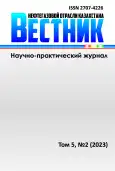Determination of uniform criteria for the applicability of technologies for enhanced oil recovery methods and development of a tool for screening these technologies
- Autores: Musharova D.A.1, Zhappasbayev B.Z.1, Orynbassar E.K.1
-
Afiliações:
- KMG Engineering
- Edição: Volume 5, Nº 2 (2023)
- Páginas: 54-68
- Seção: Oil and gas field development and exploitation
- URL: https://journal-vniispk.ru/2707-4226/article/view/250544
- DOI: https://doi.org/10.54859/kjogi108624
- ID: 250544
Citar
Texto integral
Resumo
Nowadays, many literature sources exist, containing the applicability criteria for enhanced oil recovery methods (hereinafter - EOR). The criteria were developed by the world experts, specialized oil and gas companies, determined in the laboratory and confirmed by field experience. In a number of cases, the authors compile databases with the fields, where different EOR technologies were used, evaluate their effectiveness, the complexity of the application, and the peculiarities of the implementation of the EOR technologies for certain geological and physical conditions of the fields. Based on the results of such analytical work, it is possible to determine the optimal ranges for the application of certain EOR technologies, and recommend their use in screening in order to further evaluate potentially suitable technologies under the laboratory and field conditions.
This paper presents the uniform criteria for the applicability of the key technologies of chemical, thermal, gas and microbiological EOR. To unify these criteria, an extensive literature review, a retrospective analysis of the previously tested EOR technologies, an analysis of the geological, physical and technological conditions for the use of the EOR technologies have been carried out. In order to compare the geological and physical parameters of the reservoirs and the technological parameters of the fields with certain unified applicability criteria, a screening tool has been developed, which takes into account all the necessary criteria for identifying the priority EOR technologies.
Texto integral
##article.viewOnOriginalSite##Sobre autores
Darya Musharova
KMG Engineering
Autor responsável pela correspondência
Email: d.musharova@niikmg.kz
Cazaquistão, Astana
Birzhan Zhappasbayev
KMG Engineering
Email: b.zhappasbayev@niikmg.kz
Cazaquistão, Astana
Ermek Orynbassar
KMG Engineering
Email: y.orynbassar@niikmg.kz
Cazaquistão, Astana
Bibliografia
- In the area of special attention. Kazakhstan. 2014;6:70–74. Available from: http://www.investkz.com / journals / 101 / 1318.html. Cited 2022 Aug 12. (In Russ).
- Al Adasani A, Bai B. Analysis of EOR projects and updated screening criteria. Journal of Petroleum Science and Engineering. 2010;79(2011):10–24.
- Zolotukhin AB, Pyatibratov PV, Nazarova LN, et al. Evaluation of applicability of enhanced oil recovery methods. Proceedings of Gubkin University. 2016;2(283):58–70. (In Russ).
- Armacanqui JS, Eyzaguirre LF, Prudencio G, et. al. Improvements in EOR screening, Laboratory Flood Tests and Model Description to Effectively Fast Track EOR Projects. International Petroleum Exhibition and Conference; 2017 Nov 16–17; Abu Dhabi, UAE. Available from: https://onepetro.org/SPEADIP/proceedings-abstract/17ADIP/3-17ADIP/D031S067R004/193801.
- Surguchyov ML. Secondary and tertiary methods for enhanced oil recovery. Moscow: Nedra; 1985. (In Russ).
- Alvarado V, Manrik E. Enhanced oil recovery. Field planning and development strategies Amsterdam. Мoscow: Premium Engineering; 2011.
- Sidorov IV. Issledovaniye protsessov pritoka vysokovyazkikh neftey v slabotsementirovannykh kollektorakh [dissertation]. Тюмень; 2015. (In Russ).
- Mendikovkaya KG. Vybor metodov uvelicheniya nefteotdachi v usloviyakh razrabotki Vankorskogo neftegazovogo mestorozhdeniya [dipoma]. Krasnoyarsk; 2016. (In Russ).
- Bondarenko AV. Experience in using tertiary methods for enhanced oil recovery in high-viscosity oil fields in the Perm Territory and the Komi Republic. New solutions for the development of the oil and gas industry; 2018 Sept 27–28; Perm, Russia. (In Russ).
- Khalikova DA, Petrov SM, Bashkirtseva NU. Overview of promising technologies for processing heavy high-viscosity oils and natural bitumen. Bulletin of Kazan Technological University. 2013;16(3):217–222. (In Russ).
Arquivos suplementares











